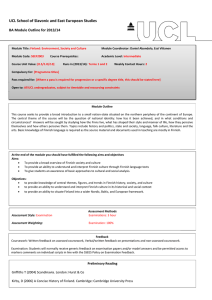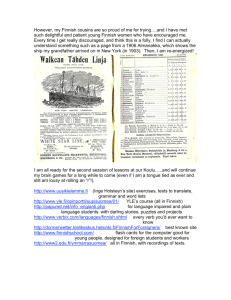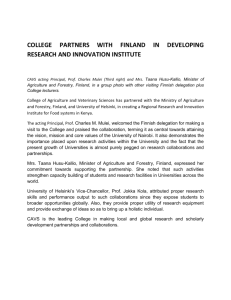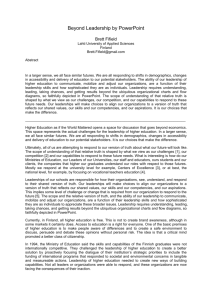Co A C nst ase S
advertisement
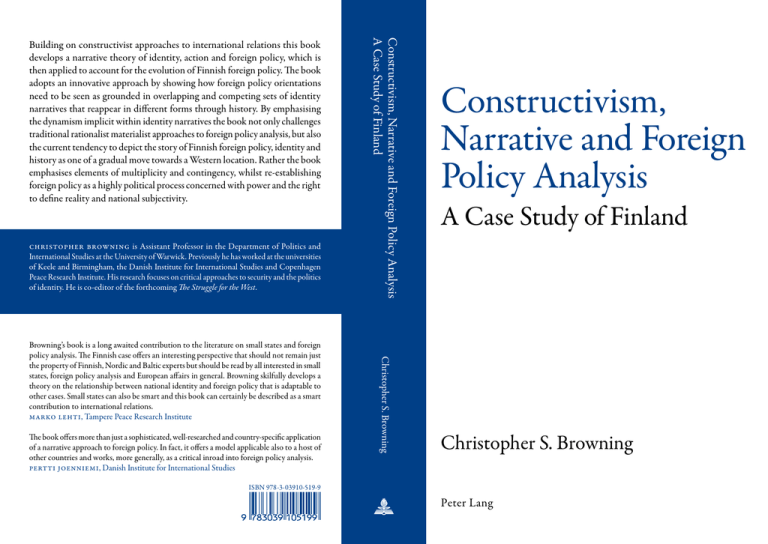
christopher browning is Assistant Professor in the Department of Politics and International Studies at the University of Warwick. Previously he has worked at the universities of Keele and Birmingham, the Danish Institute for International Studies and Copenhagen Peace Research Institute. His research focuses on critical approaches to security and the politics of identity. He is co-editor of the forthcoming The Struggle for the West. The book offers more than just a sophisticated, well-researched and country-specific application of a narrative approach to foreign policy. In fact, it offers a model applicable also to a host of other countries and works, more generally, as a critical inroad into foreign policy analysis. pertti joenniemi, Danish Institute for International Studies Christopher S. Browning Browning’s book is a long awaited contribution to the literature on small states and foreign policy analysis. The Finnish case offers an interesting perspective that should not remain just the property of Finnish, Nordic and Baltic experts but should be read by all interested in small states, foreign policy analysis and European affairs in general. Browning skilfully develops a theory on the relationship between national identity and foreign policy that is adaptable to other cases. Small states can also be smart and this book can certainly be described as a smart contribution to international relations. marko lehti, Tampere Peace Research Institute Constructivism, Narrative and Foreign Policy Analysis A Case Study of Finland Building on constructivist approaches to international relations this book develops a narrative theory of identity, action and foreign policy, which is then applied to account for the evolution of Finnish foreign policy. The book adopts an innovative approach by showing how foreign policy orientations need to be seen as grounded in overlapping and competing sets of identity narratives that reappear in different forms through history. By emphasising the dynamism implicit within identity narratives the book not only challenges traditional rationalist materialist approaches to foreign policy analysis, but also the current tendency to depict the story of Finnish foreign policy, identity and history as one of a gradual move towards a Western location. Rather the book emphasises elements of multiplicity and contingency, whilst re-establishing foreign policy as a highly political process concerned with power and the right to define reality and national subjectivity. Constructivism, Narrative and Foreign Policy Analysis A Case Study of Finland Christopher S. Browning ISBN 978 -3- 03910-519-9 Peter Lang Contents Acknowledgements 7 Chapter One 9 Introduction Chapter Two Beyond Rationalist Materialist Foreign Policy Analysis 17 Chapter Three Identity, Action and Foreign Policy 45 Chapter Four Chapter Five Chapter Six From Nation to State: The Construction of Finnish Subjectivity, 1809–1917 73 Radicalisation: Competition and Conflict in the Inter-War Period 115 From Emotionalism to Rationalism: Finland in the Cold War 169 Chapter Seven Inventing New Traditions: The Western Europeanisation of Finland 221 Chapter Eight Conclusion: Beyond Westernisation? 271 Bibliography 297 Index 323 5 Chapter One Introduction Finland’s security policy is not ‘based on historical or cultural ties and affinities or shared values, but on an unsentimental calculation of the national interest’. (Jakobson 1980, p.1042). With EU membership Finland ‘has taken its natural place as part of Western Europe to which it is bound by centuries of history’. (Lehtonen 1999, p.5). In the early 1990s debates about the future orientation of Finnish foreign and security policy became lively. At one level, such debates focused on the relevance and standing of Finland’s Cold War policy of neutrality. In this context debates raged as to whether or not the structure of the international system really had been transformed. Those perceiving a structural change to have occurred in turn claimed neutrality had lost its relevance. Others argued that signs of continuity remained evident and as such neutrality remained a relevant policy option. Such debates drew on and utilised a rationalist materialist discourse that had become grounded during the Cold War and that has been central to major schools of thought regarding the nature of international politics in general. From this perspective states (and their decision-makers) are understood as rational actors responding to changes in the structural environment in such ways so as to maximise their pre-given interests. To understand international relations and state foreign and security policies, therefore, all that is needed is a correct appraisal of the nature of the international system, the position of a particular state within that system, and an understanding of the implications for ‘state interests’ that flow from that. 9 However, whilst the neutrality debates of the early 1990s appeared to rest on rationalist appraisals of the nature of international politics and the reality of the post-Cold War world much more was at stake. Ultimately such debates were fundamentally concerned with Finnish identity and Finland’s future position and role in Europe. Rather than simply reflecting a reality ‘out there’, these debates were engaged in constituting it, and in the same process also re-constituting Finnish identity. Thus, despite frequently being dressed up in the objective rational language of social science, debates about neutrality were highly politicised as Finns struggled over the right to define ‘who we are’ and ‘where we are going’. Put otherwise, what the rationalist rhetoric leaves unexplored is precisely why a policy of neutrality was meaningful to Finns in the first place during the Cold War, as opposed to an alliance policy (with either East or West). In the first instance, therefore, this book seeks to bring a concern with identity into understanding and explaining the evolution of Finnish foreign policy. The approach adopted stands in contrast to traditional approaches to foreign policy analysis (FPA) where a concern with the constitution of identity and subjectivity is notably lacking. Indeed, to the extent that identity does make it onto the horizon of dominant FPA approaches, here labelled rationalist materialist approaches, identity is taken for granted. This is clearest in Realism’s assumption that states are self-interested power maximisers. Consequently, instead of seeing identities as malleable, multiple and historically contingent, rationalist materialist approaches understand actors’ identities to be ahistorical and uniform. Taking actors’ identities for granted and as unproblematic removes any need to analyse how particular identities emerged and transformed and what this entailed for foreign policy. This also has consequences for theorising, with rationalist materialist approaches typically searching to uncover universal causal laws of behaviour and trying to account for anomalies to anticipated outcomes where they occur. Rationalist materialist FPA is problematic for a variety of reasons that will be noted in Chapter 2. The central point, however, is that by taking subjectivity and identity as given rationalist materialist FPA is blind to the complex and historically contingent nature of social life. In contrast, this book builds on the constructivist insight that 10 it is only in intersubjective interaction that actors are able to forge a sense of being and identity at any given time. As such identities (and the interests that flow from them) are not ahistorical and fixed, but are unstable and in constant need of re-affirmation and re-construction in view of unfolding events and developing relationships. Lacking an account of how identity and subjectivity are constantly constituted and reconstituted in social interaction, rationalist materialist FPA is unable to problematise ‘how’ a particular course of action became possible, or to explain why a particular issue became framed in the way it was. Moving beyond this general constructivist insight Chapter 3 develops a narrative theory of identity and action that contends that action only becomes meaningful in the process of narrating a constitutive story of the self. In a complex and changing world it is only through emplotting ourselves in constitutive stories differentiating the self from others that we are able to attribute meaning to the social world and to construct a sense of our own identity and interests. Consequently, rather than consigning questions of identity to the sidelines, as rationalist materialist FPA does, a narrative approach to identity and action puts them at the centre of analysis. Indeed, it is argued that the very process of narrating a constitutive story that differentiates the self from others is an essential aspect of foreign policy (Campbell 1992; Doty 1993). More particularly a narrative theory of identity and action focuses attention on the temporal nature of subjectivity and points to the fact that identities are constantly open to re-negotiation and change. Whilst this approach retains an important position for actors in constituting and ordering their social world, it is argued that such freedom is also limited by the particular historical context and the meanings present at that time. This is to say that particular stories frame the boundaries of what is possible at any one time, whilst at the same time making action meaningful by projecting an image of the self into the future. Central to the narrative approach is a concern with understanding the construction of identity as imbued with contests over power. In contrast to rationalist materialist approaches, which at their extreme leave little room for agency and instead see states as responding to the impersonal forces of the international system, such as the balance of 11 power, the narrative approach brings politics back into FPA. At the same time, it will become clear that in accepting universalised notions of identity and interests rationalist materialist approaches are actually highly politicised. Rather than reflecting reality rationalist materialist approaches are actively constituting it, one central element of which are their highly normative claims of what is considered ‘rational’ and ‘sensible’ in foreign policy. Second, whilst the neutrality debates of the early 1990s were conducted largely through the rhetoric of rationalist materialism, throughout the 1990s identity also became much more clearly invoked as an explicit driver of Finnish foreign policy in both public and academic debate. In this respect, it has become common to argue that Finland’s post-Cold War foreign policy has been driven by the desire to affirm a Western identity for the country. In this light, decisions to join the EU in 1995 and to adopt the Euro in 2002 were taken primarily because of their symbolic importance as identifiers of Westernness and proof that Finland had escaped its Cold War position of being between East and West (Arter 1995; Browning 2002; Jakobson 1998; Moisio 2003). Indeed, this explicitly identity-driven rhetoric has also impacted on the neutrality debates. For example, former President Martti Ahtisaari argued in 2003 that Finland should join NATO simply because membership would finally put an end to questions of Finland’s geopolitical identity.1 Underlying some of these arguments, however, is a deeper claim that Finnish identity politics has historically always been structured around an East–West continuum, with Finland at different points in history simply occupying different points along that continuum.2 In somewhat simplified terms this can result in the depiction of Finnish history as a tale of Finland striving to escape from an eastern location to its proper and natural identification in the West. Thus, whereas during the nineteenth century Finland is depicted as having been closely tied to Russia, with independence in 1917 it escaped to a western location only to be reined in after World War II, with the final escape 1 2 12 Ahtisaari made these comments in an interview on the Yleisradio 1 TV programme, Lauantaiseura on 13/12/2003. This is implicit in Harle and Moisio (2000). to the West only coming with the collapse of the Soviet Union (see Figure 1). Figure 1 Finland 2 (Inter-War) Finland 4 (1990s) Finland 3 (Cold War) Finland 1 (Grand Duchy) WEST ----------------------------------------------------------------- EAST In this respect, the second aim of this book is to problematise this view of Finnish history, foreign policy and identity politics, by demonstrating that such claims are not neutral but are constitutive of Finnish identity in the present. Whilst the East–West discursive structure has been important at different points in Finnish history it has not been the only discourse or narrative of Finnish identity in play. For example, Joenniemi has rather argued that the preoccupation with Russia as a negative other in current debates obscures from view the emphasis that has also often been placed on differentiating Finland from Sweden, or of viewing the Nordics and the idea of Nordicity as something to be aspired for (Joenniemi 2001; 2002). Similarly, the recent emphasis on an East–West narrative structure as the core framework of Finnish foreign policy and identity has itself been challenged, especially since the events of 9/11 and the restructuring of aspects of world politics around the War on Terror. In this context, the very idea of the West, of what it stands for, of who gets to define it, and even of whether it exists has been up for grabs. Whereas European geopolitics in the twentieth century has at times been primarily structured in East–West terms, the emergence of discursive frames such as ‘New’ vs. ‘Old’ Europe, have undermined such structures. With the West internally divided, and with the West increasingly being constituted in opposition to the Islamic/non-Christian world (and with Russia even considered a member of the West in the views of many), the East–West continuum that is often postulated as 13 the core of Finnish identity debates is today being challenged. Indeed, rather than Russia standing out as a central constitutive other of identity politics for European states, it might even be argued that it is the United States that is beginning to assume this position. What such developments point to is the historically contingent nature of all identity discourses, and therefore the dangers of asserting that a particular narrative of identity, or a particular discursive structure, stands for all time. On the one hand, such assertions not only miss the complexity of identity politics, but they also stand as interventions in the domestic politics of the day, that rather than analysing how identity is being constituted at a particular point in time and indicating what implications that may have for action, instead seek to shape identity in a particular direction. Thus, even when identity has been brought into the frame in trying to understand Finnish foreign policy there has been a tendency for it to be used in politicised ways. The second aim of this book, therefore, is to highlight the politics of identity-speak and its implications for Finnish foreign policy. Rather than positing a simplified (e.g. East–West) discursive frame for understanding Finnish history and foreign policy across time, the book rather highlights that multiple narratives are always in play and that gain resonance in different ways at different times. Chapters 4 to 7 therefore provide an historical analysis of the emergence and development of different discourses that have been central in constituting Finnish identity and subjectivity at different times and how these discourses have framed the possibilities of available action for Finnish decision-makers. More specifically the book demonstrates how particular concepts and identity markers have emerged and how their interpretation and meaning has changed and developed as Finns have sought to position themselves in the world through time. Central themes and concepts here include notions of Nordicity, Europeanness, the Baltic, Russia, neutrality, sovereignty, unity, size and pragmatism, as well as how Finland has been variously positioned along the East– West continuum or related itself to notions of being in the periphery or on the edge, in contrast to a position of centrality at the core. At the same time, whilst multiple narratives of identity are always in play, each with varying constitutive effects and power, and whilst the ordering of narratives can change across time, it is also the 14 case that across different periods a certain amount of sedimentation of particular narrative structures becomes evident. Whilst the arguments for this are made in Chapter 3 this also means that the four case study chapters are each organised around a central theme that was a predominant element of identity narratives during the respective period in history. In the first instance, therefore, Chapter 4 deals with the period of nation-building and the constitution of Finland as a political subject from 1809 until Finnish independence in 1917. The chapter illustrates the constructed nature of Finnish subjectivity and highlights the political contests that have surrounded the right to define the national project. Chapter 5 focuses on the inter-war period through to the end of the Second World War and highlights how debates surrounding Finnish identity became radicalised, which in turn entailed consequences for the conduct and goals of foreign policy. Radicalisation occurred in several ways, but was most apparent in bourgeois society’s construction of an enemy image of Russia and of the Finnish left that provided the rationale for a foreign policy that sought alliances against the Eastern neighbour. In Chapter 6 it is shown how Finland’s Cold War policy of developing friendly relations with the Soviet Union relied on a reconstitution of Finnish identity in terms of pragmatism, rationalism and realism. Although Finland’s Cold War foreign policy was frequently (and often still is) presented as having been an archetype of a rational understanding of the realpolitik world and of the limitations of Finland’s geopolitical position next to the Soviet superpower that removed questions of Finnish identity from the foreign policy process, this chapter emphasises that the Cold War reappraisal needs to be explicitly understood as imbued in a series of identity practices reconstituting Finnish subjectivity. Chapter 7 turns the focus to the post-Cold War period and notes how much of Finnish foreign policy has been premised upon a particular series of understandings regarding the idea that with the end of the Cold War Finland is returning to its rightful place in Western civilisation. However, rather than reflecting a natural Western identity of Finland, it is argued Westernising narratives need to be understood as constructing this identity and are therefore highly politicised. Chapter 8, the book’s conclusion, not only summarises the arguments of the book as a whole, but also suggests that the Westernising framework of the 1990s 15 is now in trouble and in need of revision as Finnish decision-makers face the need to locate Finland in the post-9/11 world and in the context of debates over globalisation. In this situation, it is suggested the East–West framework as the central element of Finnish identity debates is increasingly being challenged by a view that what matters today is not so much where you locate yourself on an East–West plane, but rather how you relate yourself to ideas of marginality and centredness in European and world politics. Finally, given the historical sweep of the book the analysis provided in the chapters is best seen as a snapshot, rather than a claim to be making a definitive description. Of necessity some elements and narratives have received less attention than those which were more dominant. However, what each of the chapters does do is to show how at any one time a variety of narratives of selfhood have been in play and how whilst some narratives have become sedimented in the national discourse, others have been marginalised. In doing this the key aim of the book is to demonstrate how identity politics is imbued with questions of power and how foreign policy orientations emerge precisely in the competition over how to define national identity. 16 We hope you have enjoyed this short preview. Constructivism, Narrative and Foreign Policy Analysis: A Case Study of Finland by Christopher Browning can be purchased from Amazon here: http://www.amazon.co.uk/Constructivism-Narrative-Foreign-PolicyAnalysis/dp/3039105191/ Other reputable book sellers are also available.




